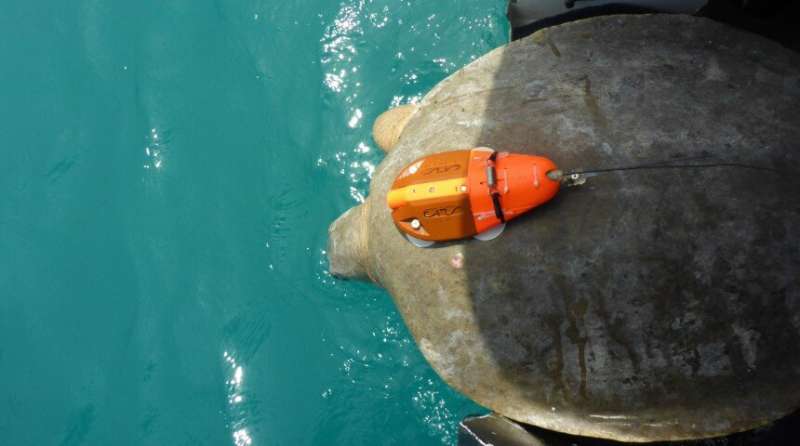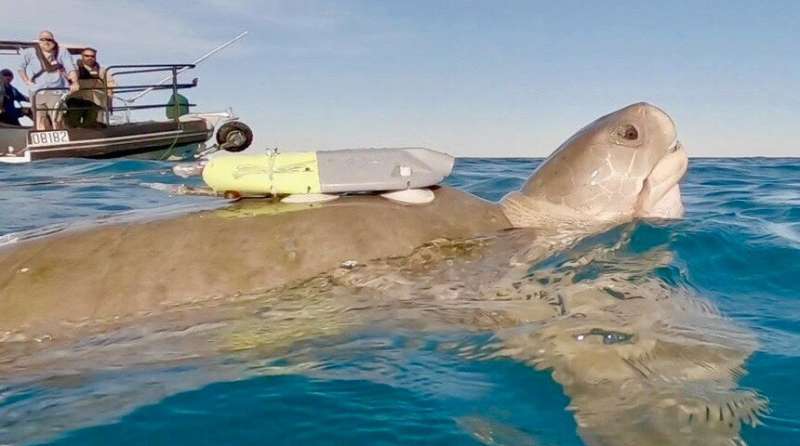Fitbit-like devices used to save turtles in Australia

Researchers from Murdoch University are using Fitbit-like technology to monitor the activity of flatback turtles to inform better conservation management practices.
Flatbacks turtles are a much-loved Australian species, but they are considered vulnerable and poorly understood.
Ph.D. candidate at Murdoch University's Harry Butler Institute, Jenna Hounslow is leading research to understand the foraging behavior of flatback turtles in Roebuck Bay—located near Broome, Western Australia—to better manage and conserve the populations.
Ms Hounslow said the project is providing valuable information to help identify unique foraging strategies and protect important resting and feeding habitats of the species.
"The tag captures the turtle's 3-D body movements, such as flipper beats, and monitors underwater activity in great detail almost like an electronic diary. They also include a high-definition camera that lets us see life from the turtle's point of view like never before," she said.
"This technology allows us to learn more about the behavior and ecology of free-ranging wild animals—like flatback turtles—that would have previously been limited to studies on captive animals," said Ms Hounslow.
Ms Hounslow explained we need to assess the anthropogenic threats, and the extent of them, faced by flatback turtles, such as marine debris, coastal industrial development, recreational vessel use and the effects of climate change, to help ensure they are not disturbed at critical foraging habitats.
"This is why we first need to understand their behavior. However, as with any animal that spends most of its life underwater, it is difficult for us to observe their behavior for extended periods without disturbing them or biasing our observations," she said.

Ms Hounslow said most scientific research to date has been done on nesting female turtles and hatchlings, due to ease of access from nesting beaches.
"This represents only a tiny period of a turtle's life. They spend most of their life at sea away from nesting beaches and only the adult females return to their nesting beaches every 2-3 years," she said.
"The project is in its early stages but we have already tagged 29 flatback turtles at Roebuck Bay, both males and females. In 2018, in collaboration with the Department of Biodiversity, Conservation and Attractions (DBCA) and Yawuru country managers sharing traditional knowledge on Yawuru sea country, we caught the first adult male flatback turtle for scientific research. This male turtle weighed over 80 kg and was the first turtle tagged for my Ph.D. research."
She explained, "We released the turtle where we caught him, and the tag popped off after a couple of days recording continuous activity and environmental data, giving us over eight hours of video and a turtles-eye-view of underwater life in Roebuck Bay for the first time."
Ms Hounslow first gained experience using the biologging technology with other aquatic species, including sharks, through volunteer work throughout her undergraduate and honors degree at Murdoch's Centre for Sustainable Aquatic Ecosystems.
Ms Hounslow's research with the Harry Butler Institute is part of the North West Shelf Flatback Turtle Conservation Program (NWSFTCP), a much larger multi-year project administered by the DBCA aiming to conserve and protect flatback turtles in Western Australia.
"Each day we're learning more about where and how much time flatbacks allocate to different behaviors, what the flatbacks are eating, as well as how they interact with other turtles and their habitat," said Ms Hounslow.
"However, we still very much lack an understanding of what flatback turtles are doing at-sea, which is why we need to study all stages of an animal's life history, so we can continue to design effective conservation and management tools to keep these beloved underwater creatures around."
More information: Harry Butler Institute: www.murdoch.edu.au/research/in … rry-butler-institute
Provided by Murdoch University




















